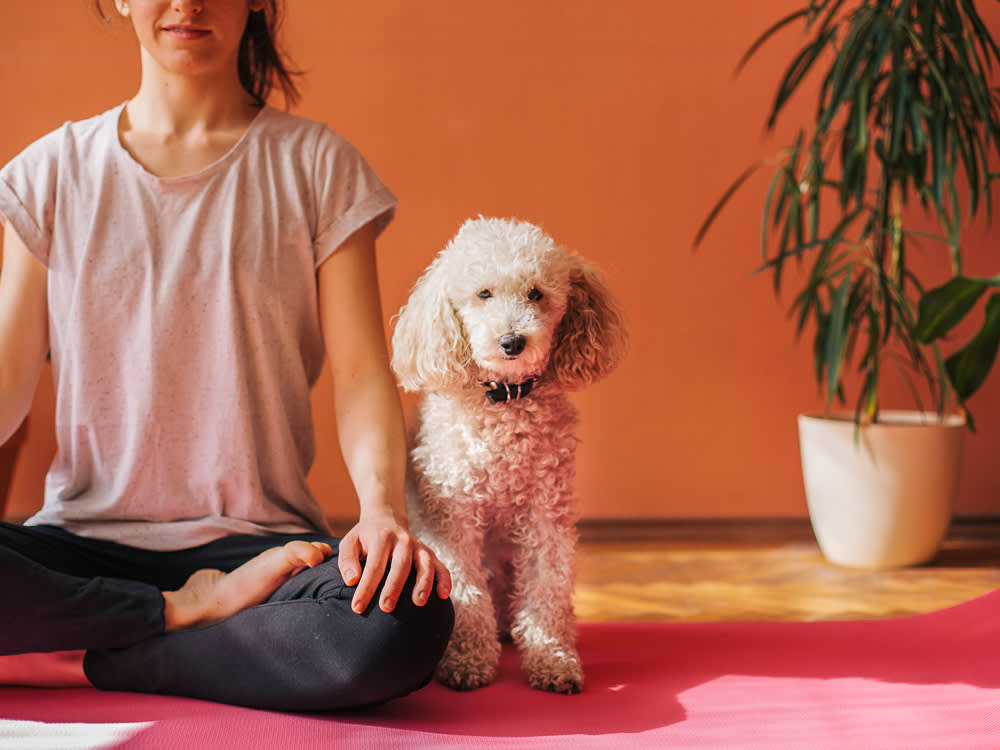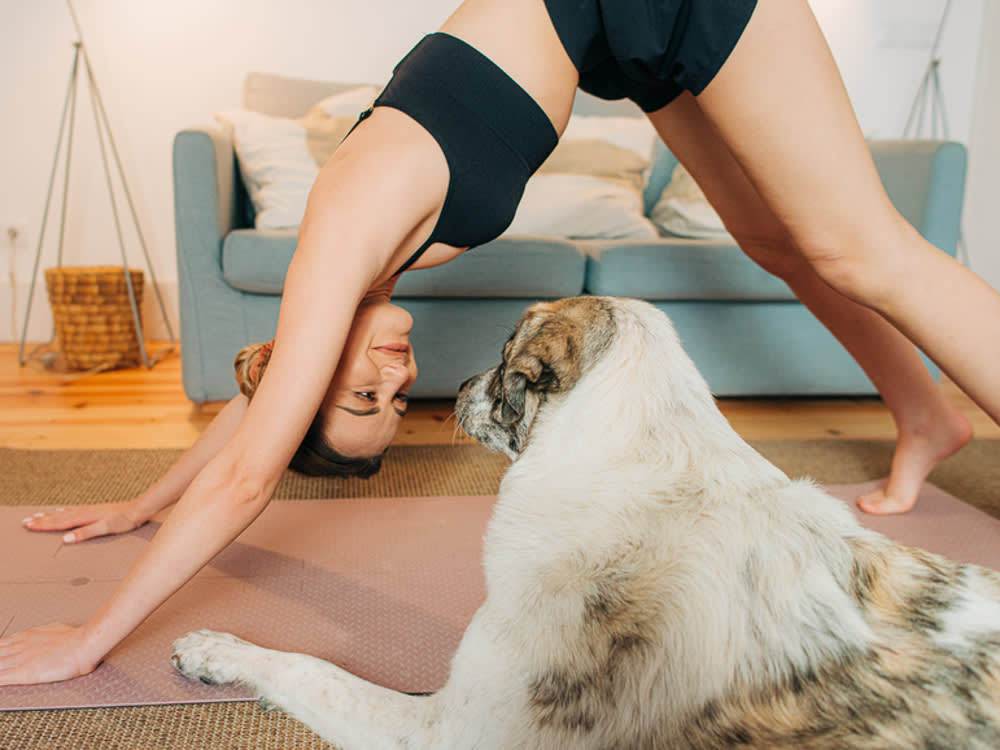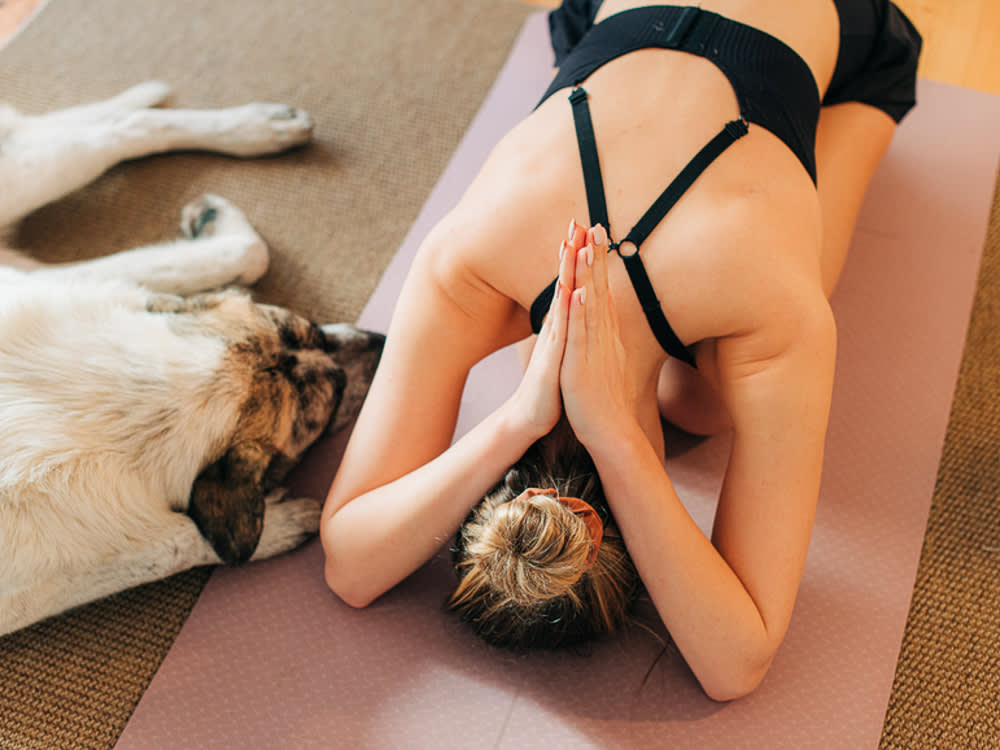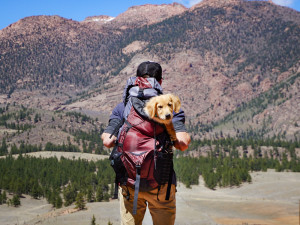So You Want to Try Doga?
Nope, that’s not a typo — dog yoga can improve the mental well-being of people and their pets. They don’t call it downward dog for nothing!

Share Article
You’ve probably seen a few viral videosopens in a new tab of dogs flawlessly following their owners’ yoga movements on beat. But dog yoga, a.k.a. “doga,” and practicing yoga with animals in general, has been around for some time. Suzi Teitelmanopens in a new tab, who has been teaching dog yoga for two decades, first started bringing her dog to a yoga class in New York after September 11th. She was already experimenting with alternative yoga practices like desk yoga and pool yoga, so it didn’t seem like a stretch. “I brought it to the forefront, but there were people sitting with their animals for thousands of years,” she says.
Along with goat yoga, dog yoga is something that captured people’s imaginations years before videos went viral on TikTok. Teitelman recalled leading a dog yoga class in Washington Square Park in New York, when people began taking photos and a flurry of media coverage followed. Cameras and students wishing to learn how to teach dog yoga have followed Teitelman since then. Over the last 20 years, she trained dozens of teachers around the world. Since the pandemic, doga has grown in accessibility and popularity as more people have become pet parents and gained more control over their schedule through remote or hybrid work setup. For dog yoga teachers like Teitelman, the pandemic has stripped limitations of in-person training and made her practice primarily remote through platforms like Zoom and WhatsApp.

littleKin™ is Kinship’s home just for puppy and kitten parents. Bop over to check out expert advice, new pet tools, and special deals—all curated for your newest family member.
opens in a new tabWhile it could be fun to try bonding with other animals like goats or cats, Teitelman says dogs are particularly well-suited for yoga sessions because they are open to training and many breeds will become invested in any activity with their humans. “People are still shocked by it,” she says, recalling her clients doubting their dogs would be interested in structured exercise. “But if they (the humans) are into it, the dogs will be into it.”
What is dog yoga?
Yoga is a Sanskrit term that means “joining” or “uniting.” It’s an ancient physical and mental discipline originally developed in India, where it also incorporates Hindu philosophy. Outside of India, yoga is more commonly viewed as a form of exercise. “Like yoga, doga balances, harmonizes, purifies and transcends the body and mind of the practitioner,” says doga teacher Madhavi Bhatia. “What makes doga unique is the practice and benefits that create a harmony and synchronization of energy flow between the [pet parent] and dog.”
If you’re curious about what doga yoga entails, the answer depends on whom you ask. A dog yoga class may vary in the level of difficulty, intention, and style. For early pioneers like Teitelman, “traditional” dog yoga means bringing your dog to a class, virtually or in person, and having them essentially join the same practice or sequence that you’re doing — whether it’s Hatha, Vinyasa, or a combination of yoga traditions. “You can sit and breathe with your dog,” she says, noting that you can start with simple grounding steps. “You’re trying to be more like your dog.”
Long-time doga enthusiast and former star of Animal Planet’s “K9 Karma” Kari Harendorf agrees. “Doga is a partner yoga class that people do with their dogs,” says Harendorf. “It’s very much like a dance, using the dogs as we would use a traditional dance partner … just as a teacher might assist you to push deeper into the pose.”
Over the years, different yoga centers and teachers have interpreted dog yoga in different ways. In Canada, Keith Mitchener started Puppy Yogaopens in a new tab in 2018, in which a litter of eight-week-old puppies runs around the class while you try (obviously in vain) to focus on your downward dog. As business took off before the pandemic, he expanded to three cities. He was preparing to bring Puppy Yoga to LA before the whole world shut down. “It's a super, super basic class — it's just supposed to be able to entice people to start looking at the benefits of yoga,” Mitchener says. “I tell them that you just get to hang out with puppies.”
Other teachers like Megan Hope at Le Doggie Coolopens in a new tab, a doggie daycare and coffee shop in Brooklyn, may ask you to bring your dog to a doga classopens in a new tab an hour early “so they can play and burn some energy so the class runs smoothly.” Either way, it’s a good idea to research the venue and ask questions about what you can expect before booking your first doga class. And ask your vet if there are any poses your pup should avoid altogether.
Unless you live in a large city, it can be a challenge to find doga classes. If there are none near you, contact a local yoga studio and ask if a dog-loving instructor would consider teaching one at a shelter or dog training facility.
What are the benefits of dog yoga?
Advocates of doga say the benefits can range from relaxation, socialization, and alleviation of anxiety to muscle strengthening, a higher sense of bonding, and mental well-being both for the dogs and pet parents. In a way, dog yoga is similar to a therapy dog session with elements of training and quality time with your pet. Ann Berger, a physician and researcher at the NIH Clinical Center in Bethesda, MD, studies mindfulness and ways to alleviate pain or reduce stress. “Dogs are very present,” she wroteopens in a new tab. “If someone is struggling with something, they know how to sit there and be loving. Their attention is focused on the person all the time.” Indeed, when Ivanka Siolkowsky took Mitchener’s Puppy Yoga class soon after the loss of her mother, she shared on Instagramopens in a new tab, “I think the puppies could sense that I needed them because all six of them kept coming to me and laying on me all at once.”
Improve Training
There are other benefits to doga, for example, teaching your dog to allow you to touch any part of their body, including their paws and toes. Doing gentle doga stretches can help a dog overcome a fear of nail clippingopens in a new tab. It can also come in handy with dogs with impatient and pushy personalities. They can not only learn to tolerate the stretchesopens in a new tab, but they can also learn to offer their legs in anticipation.
Mindfulness
Being in close contact with your dog’s body provides an opportunity for a weekly health checkopens in a new tab as well. Harendorf recalls that one of her students found a lump on their dog’s inner thigh that they might never have discovered without their weekly doga class. (Thankfully, the lump proved benignopens in a new tab.) Senior and physically handicapped dogs can also benefit from doga as long as the routine is adapted to their needs.
Stronger Bonds
“Doga brings us back to more simple things,” says Harendorf. “My dogs grew up being city dogs, where there are these big dog runs and people just bring their dogs and visit in their social circle or talk on the phone or read the newspaper. We’re so busy, so plugged in with the cell phones. We can walk our dogs and not pay attention to them. Doga is 45 minutes of undivided attention. It is a gift.”
As we emerge from the pandemic and begin socializing again with other humans and animals, Mitchener says there is greater need for dog yoga than ever before. “Mental health issues are skyrocketing and these classes are a huge mental health boost. They’re also community-building and really bring out the inner child in everyone — every age, every race, every gender. Puppy yoga is a win-win.”

Daria Solovieva
Daria Solovieva is a business journalist and a certified meditation teacher based in California.
Related articles
![Man backpacking with his Golden Retriever puppy in a state park]() opens in a new tab
opens in a new tab51 Dog-Friendly US Spots to Visit With Your Pup This Summer
Where to go and what to do—from Alabama to Wyoming.
![jess king, sophia urista and chicken]() opens in a new tab
opens in a new tabJess King and Sophia Urista’s Rescue Dog Teaches Them How to Chill
The kinetic Peloton-instructor-and-musician power couple are as passionate about their pets as they are their bustling careers.



